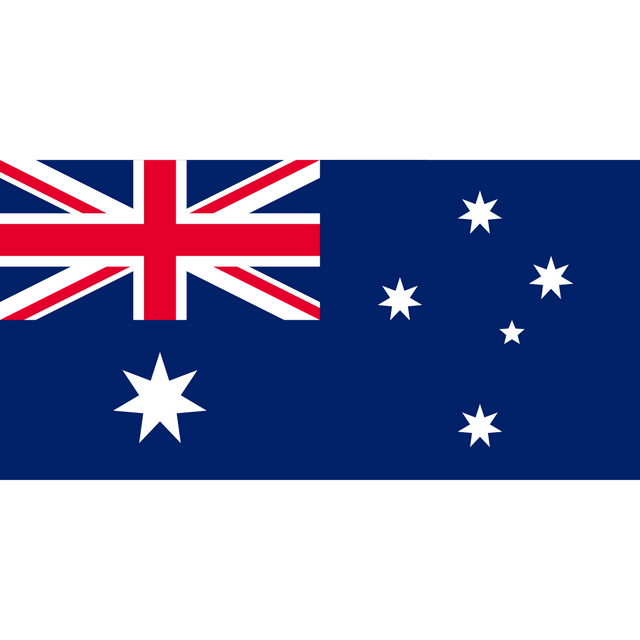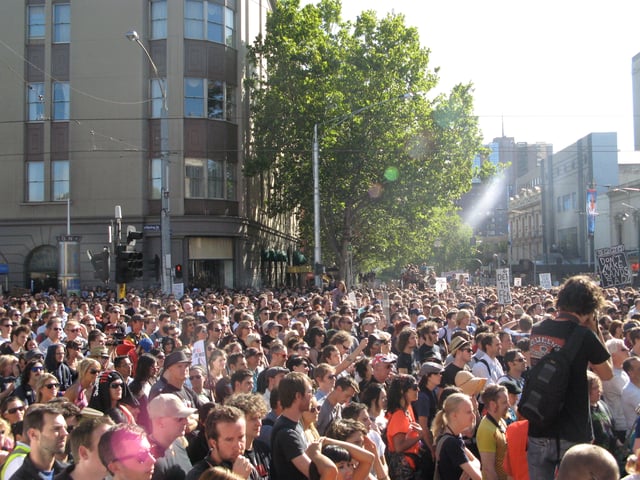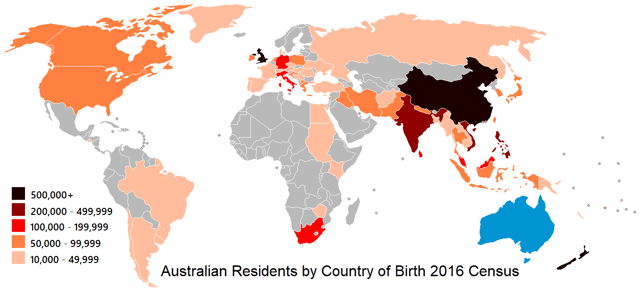Australians

Australians

| Regions with significant populations | |
|---|---|
| Australia | 25,332,111 |
| United States | 94,000–200,000[7][8] |
| United Kingdom | 113,000[9] |
| Hong Kong | 90,000[10][11] |
| New Zealand | 70,000[12] |
| Canada | 62,910[13] |
| Indonesia | 55,000[14] |
| Greece | 50,000 |
| Italy | 30,000[14][15] |
| Lebanon | 20,000–25,000[14][16] |
| Singapore | 20,000 (2011)[17] |
| Sweden | 7,942[18] |
| France | 3,000 (2011)[19] |
| Brazil | 1,000[20] |
| Languages | |
| English·Other minoritylanguages[21] | |
| Religion | |
| Christianity(Protestantism,Roman Catholicism),Islam,Buddhism,Hinduismand other minorityreligions[22] | |
Australians, colloquially known asAussies (/ˈɒzi/), are citizens and nationals of the Commonwealth of Australia, although some dual citizens, expatriates and permanent residents may also claim Australian nationality. Home to people of many different ethnic origins, religious and national origins, the Australian culture and law does not correspond nationality with race or ethnicity, but with citizenship and loyalty to the country. Australia is a multicultural society and has the world's ninth-largest immigrant population, with immigrants accounting for 29% of the population.[23]
Life is a lot of work.
What is it that gives us the strength to continue when we are tired and burned out?
Sometimes an inspirational idea can help us renew ourselves and be filled with strength to fulfill our life's purpose.
Inspiration comes in many forms.
However, the root of all inspiration is the idea that our lives are meaningful.
Inspiration is knowing that what I do matters deeply to the universe.
When you have the feeling that your actions are meaningful, you will become filled with strength and vigor to fulfill your life's purpose.Words
have the power to motivate us and help us to live more intentionally. Each
of us have areas of our lives that we would like to improve, and there are quotes and words of wisdom that can almost always be found to motivate and inspire us in these different areas. As
we strive to grow and improve ourselves, it's important to choose the words we speak to ourselves carefully. I've
listed below some words that represent possible areas in which individuals may hope to grow and have included quotes that might help motivate and inspire personal change in each area.
Many early settlements were penal colonies, which were home to transported convicts (who often later became ex-convicts) along with free settlers and administrators. Immigration increased exponentially from the 1850s, following a series of gold rushes. Further waves of immigration occurred after the First and Second World Wars, with many post-World War II migrants coming from Europe, Asia, and the Pacific Islands, and to a lesser degree, from Latin America and Africa. Prior to British settlement, Australia was inhabited by various indigenous peoples – Aboriginal Australians, Aboriginal Tasmanians and Torres Strait Islanders, a Melanesian people. A small percentage of present-day Australians descend from these peoples.
Life is a lot of work.
What is it that gives us the strength to continue when we are tired and burned out?
Sometimes an inspirational idea can help us renew ourselves and be filled with strength to fulfill our life's purpose.
Inspiration comes in many forms.
However, the root of all inspiration is the idea that our lives are meaningful.
Inspiration is knowing that what I do matters deeply to the universe.
When you have the feeling that your actions are meaningful, you will become filled with strength and vigor to fulfill your life's purpose.Words
have the power to motivate us and help us to live more intentionally. Each
of us have areas of our lives that we would like to improve, and there are quotes and words of wisdom that can almost always be found to motivate and inspire us in these different areas. As
we strive to grow and improve ourselves, it's important to choose the words we speak to ourselves carefully. I've
listed below some words that represent possible areas in which individuals may hope to grow and have included quotes that might help motivate and inspire personal change in each area.
The development of a separate Australian identity and national character is often linked with the anti-transportation and nativist movements and the Eureka Rebellion during the colonial period and in the lead-up to Federation, as well as the period surrounding the First World War. However, Australian culture predates the federation of the Australian colonies by several decades – Australian literature, most notably the work of the bush poets, dates from colonial times. Modern Australian identity draws on a multicultural and Anglo-Celtic cultural heritage.[24]
| Regions with significant populations | |
|---|---|
| Australia | 25,332,111 |
| United States | 94,000–200,000[7][8] |
| United Kingdom | 113,000[9] |
| Hong Kong | 90,000[10][11] |
| New Zealand | 70,000[12] |
| Canada | 62,910[13] |
| Indonesia | 55,000[14] |
| Greece | 50,000 |
| Italy | 30,000[14][15] |
| Lebanon | 20,000–25,000[14][16] |
| Singapore | 20,000 (2011)[17] |
| Sweden | 7,942[18] |
| France | 3,000 (2011)[19] |
| Brazil | 1,000[20] |
| Languages | |
| English·Other minoritylanguages[21] | |
| Religion | |
| Christianity(Protestantism,Roman Catholicism),Islam,Buddhism,Hinduismand other minorityreligions[22] | |
Overview
The majority of Australians or their ancestors immigrated within the past four centuries, with the exception of the Indigenous population and other outer lying islands who became Australian through expansion of the country. Despite its multi-ethnic composition, the culture of Australia held in common by most Australians can also be referred to as mainstream Australian culture, a Western culture largely derived from the traditions of British and Irish colonists, settlers, and immigrants.
The Colony of New South Wales was established by the Kingdom of Great Britain in 1788, with the arrival of the First Fleet, and five other colonies were established in the early 19th century, now forming the six present-day Australian states. Large-scale immigration occurred after the First and Second World Wars, with many post-World War II migrants coming from Southern and Eastern Europe introducing a variety of elements. Immigration from the Middle East, south and east Asia, Pacific Islands, Africa, and Latin America has also been having an impact.
The predominance of the English language, the existence of a democratic system of government drawing upon the British traditions of Westminster Government, Parliamentarianism and constitutional monarchy, American constitutionalist and federalist traditions, Christianity as the dominant religion, and the popularity of sports originating in (or influenced by) the British Isles, are all evidence of a significant Anglo-Celtic heritage. Australian culture has diverged significantly since British settlement. Sporting teams representing the whole of Australia have been in existence since the 1870s.
Australians are referred to as "Aussie" and "Antipodean".[25][26] Australians were historically referred to as "Colonials", "British" and "British subjects".[27][28][29][30] As a result of many shared linguistic, historical, cultural and geographic characteristics, Australians have often identified closely with New Zealanders in particular. Furthermore, elements of Indigenous, American, British, and more recent immigrant customs, languages, and religions have also combined to form the modern Australian culture.[31]
Ancestries
Until the Second World War, the vast majority of settlers and immigrants came from the British Isles, and a majority of Australians have some British or Irish ancestry. These Australians form a broad ethnic category known as Anglo-Celtic Australians. Asian Australians constitute the largest broad ethnic minority category by a large margin, at 16.15% of the population at the 2016 census.[32][33] In the 2016 Australian census, the most commonly nominated ancestries were English (36.1%), Australian (33.5%),[1] Irish (11.0%), Scottish (9.3%), Chinese (5.6%), Italian (4.6%), German (4.5%), Indian (2.8%), Greek (1.8%), and Dutch (1.6%).[35]
European

Melburnians during the live music rally in 2010
Today, Australians of Anglo-Celtic and other European descent are the majority in Australia, estimated at around 70% of the total population.[35][37][38] Historically, European immigrants had great influence over Australian history and society, which resulted in the perception of Australia as a Western country.[39][40]
Since soon after the beginning of British settlement in 1788, people of European descent have formed the majority of the population in Australia. The majority of Australians are of British – English, Scottish, Welsh, Cornish, or Manx – and Irish ancestral origin (grouped together as "Anglo-Celtic").
Although some observers stress Australia's convict history, the vast majority of early settlers came of their own free will.[41] Far more Australians are descended from assisted immigrants than from convicts, the majority being British and Irish.[42] About 20% of Australians are descendants of convicts.[43] Most of the first Australian settlers came from London, the Midlands and the North of England, and Ireland.[44][45][46] Settlers that arrived throughout the 19th century were from all parts of the United Kingdom and Ireland, a significant proportion of settlers came from the Southwest and Southeast of England, from Ireland and from Scotland.[47] Anglo-Celtic Australians (Northern European settlers from England, Scotland, Wales, and Ireland) have been highly influential in shaping the nation's character. By the mid-1840s, the numbers of freeborn settlers had overtaken the convict population. In 1888, 60 percent of the Australian population had been born in Australia, and almost all had British ancestral origins. Out of the remaining 40 percent, 34 percent had been born in the British Isles, and 6 percent were of European origin, mainly from Germany and Scandinavia.[48] In the 1840s, Scots-born immigrants constituted 12 percent of the Australian population. There were 1.3 million British migrants to Australia in the period from 1861–1914, of whom 13.5 percent were Scots. 5.3 percent of the convicts transported to Eastern Australia between 1789 and 1852 were Scots.[49] By 1850, there were 290,000 Aboriginal Australians. The European population grew from 0.3 percent of the population of the continent at 1800 to 58.6 percent in 1850.[50] Germans formed the largest non-British community for most of the 19th century.[51] The census of 1901 showed that 98 percent of Australians had Anglo-Celtic ancestral origins, and was considered as "more British than Britain itself".[52] Between 1901 and 1940, 140,000 non-British European immigrants arrived in Australia (about 16 percent of the total intake).[53] Before World War II, 13.6 percent were born overseas, and 80 percent of those were British.[54] In 1939 and 1945, still 98 percent of Australians had British/Anglo-Celtic ancestral origins.[55] Until 1947, the vast majority of the population were of British origin.[56] During the 1950s, Australia was the destination of 30 per cent of Dutch emigrants and the Netherlands-born became numerically the second largest non-British group in Australia.[57] In 1971, 70 percent of the foreign born were of European origin. Abolition of the White Australia Policy in 1957 by the Menzies government, often incorrectly attributed to a later Labor government, led to a significant increase in non-European immigration, mostly from Asia and the Middle East.
Asian
At the 2016 census, there were 3,514,915 nominations of ancestries classified by the Australian Bureau of Statistics as falling within the geographical categories of East Asia, Southeast Asia and Central and Southern Asia.[33] This represents 16.15% of persons who nominated their ancestry.[59] 2,665,814 persons claimed one of the six most commonly nominated Asian ancestries, namely Chinese, Indian, Filipino, Vietnamese, Korean and Sri Lankan, at the 2016 census.[60] Persons claiming one of these six ancestries alone represented 12.25% of the total population who nominated their ancestry.[60][2]
Chinese, Indian, Filipino, Vietnamese, Korean and Sri Lankan are the most commonly nominated Asian ancestries in Australia.[60] Chinese Australians constituted 5.6% of the Australian population and Indian Australians constituted 2.8 percent at the 2016 census.
Indigenous
Indigenous Australians are descendants of the original inhabitants of the Australian continent.[61] Their ancestors are believed to have migrated from Africa to Asia around 70,000 years ago[62] and arrived in Australia around 50,000 years ago.[63][64] The Torres Strait Islanders are a distinct people of Melanesian ancestry, indigenous to the Torres Strait Islands, which are at the northernmost tip of Queensland near Papua New Guinea, and some nearby settlements on the mainland. The term "Aboriginal" is traditionally applied to only the indigenous inhabitants of mainland Australia and Tasmania, along with some of the adjacent islands. Indigenous Australians is an inclusive term used when referring to both Aboriginal and Torres Strait islanders, i.e.: the "first peoples".
Dispersing across the Australian continent over time, the ancient peoples expanded and differentiated into hundreds of distinct groups, each with its own language and culture.[65] More than 400 distinct Australian Aboriginal peoples have been identified across the continent, distinguished by unique names designating their ancestral languages, dialects, or distinctive speech patterns.[66]
In 1770, fearing he had been pre-empted by the French, James Cook changed a hilltop signal-drill on Possession Island in Torres Strait, into a possession ceremony, fabricating Britain's claim of Australia's east coast.[67] Eighteen years later, the east coast was occuptied by Britain and later the west coast was also settled by Britain. At that time, the indigenous population was estimated to have been between 315,000 and 750,000,[68] divided into as many as 500 tribes speaking many different languages. In the 2006 Census, 407,700 respondents declared they were Aboriginal, 29,512 declared they were Torres Strait Islanders, and a further 17,811 declared they were both Aboriginal and Torres Strait Islander.[69] After adjustments for undercount, the indigenous population as of end June 2006 was estimated to be 517,200, representing about 2.5% of the population.[68]
Country of birth

Country of birth of Australian residents (2016)[71]
In 2018, 29% of the Australian resident population, or 7,341,910 people, were born overseas.[23]
The Australian resident population consists of people who were born in the following countries:
| Source:Australian Bureau of Statistics(2018)[23] | |
|---|---|
| Place of birth | Estimated resident population[3] |
| Australia | 17,650,000 |
| England][4] | 992,000 |
| Mainland China][5] | 651,000 |
| India | 592,000 |
| New Zealand | 568,000 |
| Philippines | 278,000 |
| Vietnam | 256,000 |
| South Africa | 189,000 |
| Italy | 187,000 |
| Malaysia | 174,000 |
| Scotland][4] | 135,000 |
| Sri Lanka | 134,500 |
| South Korea | 116,120 |
| Germany | 114,580 |
| Greece | 108,830 |
| United States | 108,610 |
| Hong Kong]SAR | 100,620 |
For more information about immigration see Immigration to Australia and Foreign-born population of Australia.
Historical population
The data in the table is sourced from the Australian Bureau of Statistics[73][74] Note that population estimates in the table below do not include the Aboriginal population before 1961. Estimates of Aboriginal population prior to European settlement range from 300,000 to one million, with archaeological finds indicating a sustainable population of around 750,000.[75]
Citizenship
Australian citizenship did not exist before 26 January 1949.
Before then, people born in Australia were British subjects.
People born in Australia (including Norfolk Island, Cocos (Keeling) Islands and Christmas Island) on or after 20 August 1986 are Australian citizens by birth if at least one parent was an Australian citizen or a permanent resident at the time of the person's birth.[76]
Statistics do not exist as to the number of Australians who currently are dual citizens.
In 2000, it was estimated to be 4 to 5 million people.[77]
Current population
The current Australian resident population is estimated at 25,537,000 (26 September 2019).[78] This does not include an estimated 1 million Australians living overseas, but it includes Australians born overseas.
There are an estimated 1 million Australians (approximately 5% of the population) residing outside Australia.
The Trans-Tasman Travel Arrangement facilitates open migration to and from New Zealand.[79]
Culture
Language
Although Australia has no official language, English has always been entrenched as the de facto national language.[80] Australian English is a major variety of the language with a distinctive accent and lexicon,[81] and differs slightly from other varieties of English in grammar and spelling.[82] General Australian serves as the standard dialect.
According to the Australian Bureau of Statistics (ABS) 2016 census, English is the only language spoken in the home for close to 72.7% of the population. The next most common languages spoken at home are:[83]
Mandarin (2.5%)
Arabic (1.4%)
Cantonese (1.2%)
Vietnamese (1.2%)
Italian (1.2%).
A considerable proportion of first- and second-generation migrants are bilingual.
Over 250 Indigenous Australian languages are thought to have existed at the time of first European contact, of which less than 20 are still in daily use by all age groups.[84][85] About 110 others are spoken exclusively by older people.[85] At the time of the 2006 census, 52,000 Indigenous Australians, representing 12% of the Indigenous population, reported that they spoke an Indigenous language at home.[86] Australia has a sign language known as Auslan, which is the main language of about 5,500 deaf people.[87]
Religion
Australia has no official religion; its Constitution prohibits the government from establishing one, or interfering with the freedom of religion.[88]
Australians have various religions and spiritual beliefs.
Majority (52.1%) were Christian, while 30.1% of the population reported as having no religion, of those reporting as having religious affiliations according to the 2016 census.[89] As in many Western countries, the level of active participation in church worship is lower than would be indicated by the proportion of the population identifying themselves as Christian; weekly attendance at church services was about 1.5 million in 2001,[90] about 7% of the population (21.5 million[91]) that year.